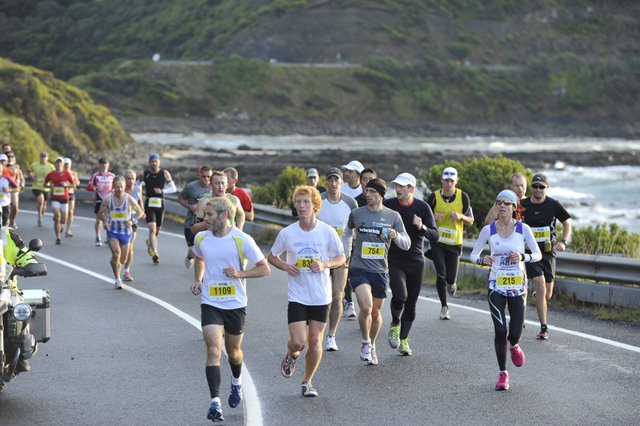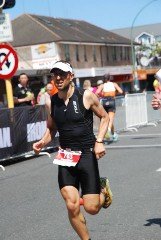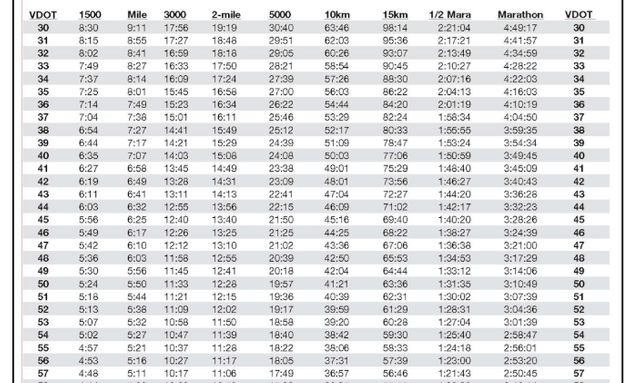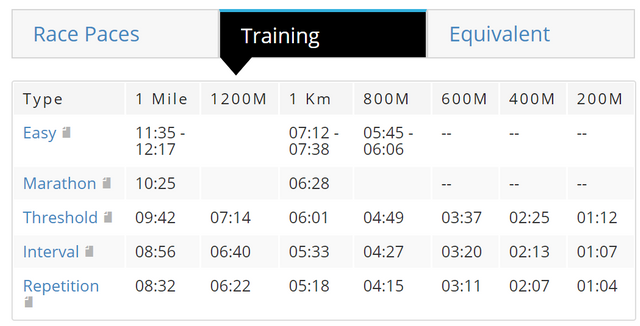Using Jack Daniels Run Formula For Your Next 10k for @runningproject - Week 1

Image from the Great Ocean Road Marathon 2013
Last week we discussed the idea of training for, and racing 10km races and thought it might be a good idea to set out a training plan over the next six weeks where you can work towards a 10km race. With six weeks of posts, I also thought it would be a good idea to introduce Jack Daniels Running Formula as part of the training plan.
Last week we discussed the idea of training for, and racing 10km races and thought it might be a good idea to set out a training plan over the next six weeks where you can work towards a 10km race. With six weeks of posts, I also thought it would be a good idea to introduce Jack Daniels Running Formula as part of the training plan.
If you have not heard of his training methods, Jack Daniels Training Formula isn't as straightforward as some of the other training plans I've reviewed recently, so it'll be great to have almost 6 posts to bring you all the specific details and how to implement it into your training plan. This post is going to have a lot of information to get us started, let's not delay.
The Running Formula has been devised by Jack Daniels from over more than fifty years of experience and research in sports science and coaching, and if you're interested in reading his book, you can find it at the following link:
https://www.bookdepository.com/search?searchTerm=Daniels%27+Running+Formula-3rd%C2%AD+Edition&search=Find+book
Basic Physiological Systems For Runners
The basis of the book examines the basic physiological systems which Daniels devised to help understand why we're training in a specific way. The systems are:
- Cardiovascular System - Cardiac output or how much blood your heart can pump and the oxygen carrying capacity of the blood.
- Muscular System - Your muscles ability to utilize oxygen, remove waste and store glycogen.
- Lactate Threshold - This is when lactic acid production and removal of lactic acid are equal and the goal is to make sure you are able to run as fast as possible.
- Aerobic Capacity - The maximum amount of oxygen your body can take in and use during exercise and referred to as VO2Max.
- Speed - Generally how fast someone can run.
- Running Economy - How efficient you can run but refers to your use of oxygen.
These six systems are the basis of Daniels training goals with specific workouts taylored to improve each of these systems. Daniels has developed specific training zones to help guide runners in using his plans:
- Easy Running(E) 65-70% of max heart rate and includes warm up, cool down, recovery runs and long runs. These training sessions are designed to help improve to help cardiovascular systems and overall energy.
- Marathon Pace(M) 75-84% of max heart rate and takes the place of a long run. Usually doesn't exceed 90 minutes in length and designed to improve the runners confidence over longer distances.
- Threshold Training(T) comfortably hard running for between 20 to 60 minutes at 88% to 92% max heart rate. This is to help build endurance, improve lactate threshold in runners.
- Interval Training(I) short intervals of 98% to 100% of max heart rate. These are shorter intervals of about 5 minutes with an equal recovery time, used to increase aerobic capacity.
- Repetition Training(R) is aimed at improving both speed and running economy. The repeats are run at slightly higher than maximum heart rate with each repetition not last longer than 2 minutes. These are designed to help improve the runner's speed, power and running economy.
Training programs are then determined by a runners current fitness levels. Here we use recent race times under normal conditions to determine a runners fitness. This brings us to the Daniels VDOT values table. We can use the table to show our recent race results, which gives us a VDOT score. This VDOT score then provides an intensity of pace to be running at for the specific training zones.
VDOT Training Tables From Jack Daniels Running Formula
As an example, if you ran your most recent 10km race in just over 1 hour, we would have a VDOT value of 32. We can then use his pace tables to then calculate the pace we need to then run at for our different training zones. Daniels has made this even simpler, with the following calculator:
https://runsmartproject.com/calculator/
Planning Your Training
The next step would be to plan your training season and this is where Daniels breaks up your season into specific phases:
- Foundation and Injury Prevention(FI) - Steady easy runs while gradually increasing distance and increasing mileage(E)
- Early Quality(EQ) - Start to introduce faster workouts and prepare the runner for the next phases(R, I, T, L)
- Transition Quality(TQ) - The most stressful phase of the training season and designed to optimize the components specific to the race being trained for(I, T, M)
- Final Quality(FQ) - Final preparation for the main event(T, M)
Daniels promotes three quality run sessions a week with the phase you are in determining the types of sessions used for the quality work. Optimally we would have four weeks of training at each phase, but that could take a while. As most of the people reading this, would already have some basic run preparation and endurance base behind them, we are going to hold this program for 6 weeks, where we will break the season up as listed below:
Week 1 - Early Quality Phase(1 week total)
Week 2 to Week 4 - Transition Quality(3 weeks total)
Week 5 to Week 6 - Final Quality(2 weeks total)
Over the next 6 weeks we will provide a weekly training plan for a beginner and intermediate runner, hoping to bring a flexible program that people can alter and taylor to their needs.
Beginner Plan
This is for someone aiming to finish between 1 hour and an 1 hour and 10 minutes. This person should still have some running behind them and hopefully able to complete a 5km run without stopping.
Intermediate Training Plan
This is for someone who has been constantly running for more about 6 months and aiming to finish a 10km run in between 50 minutes and 1 hour. They should hopefully have run one or two 10km races and should be able to run 10km without stopping.
10km Training Plan - Week 1
So let's start from the start...Week 1. Here we will have three quality training sessions which are the most important, with hopefully one day of rest or easy running in between each to allow the body to recover. We start the week with a longer run, and then the last two quality run sessions are Repeats.
Beginner 10km Plan - Week 1
Quality Session Day 1
5km run at approx 7 minutes 20 seconds per kilometer(11 minutes 40 seconds per mile). Finish of the run with 6 x 10 second strides, recovering for 30 seconds between each stride.
Quality Session Day 2
(4km Total)
1km warm up at an easy pace
10 x 200 meter Repeats at 1 minute and 5 seconds per repeat, with 200 meters easy jog to recover
1km cool down at an easy pace
Quality Session Day 3
(3.4km Total)
1km Warm up at an easy pace
7 x 200 meter Repeats at 1 minute and 5 seconds per repeat, with 200 meters easy jog to recover
1km cool down at an easy pace
Intermediate 10km Plan - Week 1
Quality Session Day 1
8km run at approx 6 minutes 40 seconds per kilometre(10 minutes 45 seconds per mile). Finish of the run with 6 x 10 second strides, recovering for 30 seconds between each stride.
Quality Session Day 2
(5km Total)
2km warm up at an easy pace
10 x 200 metre Repeats at 59 seconds per repeat, with 200 metres easy jog to recover
1km cool down at an easy pace
Quality Session Day 3
(4.4km Total)
2km Warm up at an easy pace
7 x 200 metre Repeats at 59 seconds per repeat, with 200 metres easy jog to recover
1km cool down at an easy pace
NOTE: For both training plans
Strides should be run at the same pace as the repeats but for only 10 seconds
Recovery Days should only be run if the runner is feeling good and could repeat this weeks Quality Session Day 1.
For our next post, we are going to discuss Daniels guiding principles of training and how we can understand the way the body is stressed during exercise to hopefully bring about a positive reaction. We will also be moving into the next phase of training which will increase the intensity of some of our training, so I hope you keep reading with us.

Now over two years ago, a pic of me running Ironman New Zealand
About the Author
Hey I'm Vince, an Aussie living in New Zealand, trying my best to make the most of the time I have. I work as a Software Engineer but love to run and all aspects of it, including geeking out on the latest science to help get the most out of my body.
For more information about @runningproject please see the latest status report:
https://steemit.com/runningproject/@runningproject/the-steem-running-project-8th-status-report-upvotes-forever-in-all-posts-of-our-approved-runners
And don’t forget to vote for your favorite author of the week: https://steemit.com/runningproject/@runningproject/vote-your-running-author-of-the-week-the-steem-running-project-wk19-by-runningproject
Posted by @run.vince.run on behalf of the @runningproject


Go here https://steemit.com/@a-a-a to get your post resteemed to over 72,000 followers.
Thanks @run.vince.run for an interesting post.
I would like to become a member of runningproject.
My contribution post is this:
https://steemit.com/ita/@moncia90/my-runningproject-ep-0
Thank you!
Excellent post mate!
Great to see another running program on here! Nice work Vince.
I start everything with a swig of scotch beforehand.
Yeah it helps to keep both fluids and sugar levels high.
Regards @run.vince.run
Very informative post.